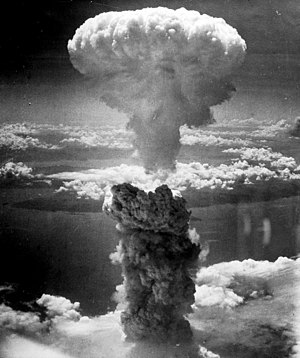And then there was Chernobyl, Three Mile Island, Fukushima And Lies and Lies and More Lies.
Effects of nuclear explosions on human health
- Initial stage—the first 1–9 weeks, in which are the greatest number of deaths, with 90% due to thermal injury and/or blast effects and 10% due to super-lethal radiation exposure
- Intermediate stage—from 10–12 weeks. The deaths in this period are from ionization radiation in the median lethal range
- Late period—lasting from 13–20 weeks. This period has some improvement in survivors' condition.
- Delayed period—from 20+ weeks. Characterized by "numerous complications, mostly related to healing of thermal and mechanical injuries coupled with infertility, sub-fertility and blood disorders caused by radiation." Also, ionizing radiation from fallout can cause genetic effects, birth defects, cancer, cataracts and other effects in organs and tissue.
Some scientists estimate that if there were a nuclear war resulting in 110 Hiroshima-size nuclear explosions, it would cause significant loss of life in the tens of millions. Climatology hypothesis is that if enough firestorms were created, a great deal of soot would be thrown up into the atmosphere which would blanket the earth, causing the disruption of food chains, in what is termed a Nuclear Winter scenario.[1][2]
Beginning in the 1950s, American and Soviet scientists embarked on a perilous race to see who could build and detonate the world's largest bomb. The results exceeded all expectations about how big a bomb could be built. Initially, the Americans led the way, but then left the field clear for the Soviet Union to break all records.
Secrets of the Dead chronicles how the bomb-makers on both sides were working blind as they pushed science into unknown territory to build The World's Biggest Bomb. As we approach the 50th anniversary of the detonation of the most powerful bomb ever constructed – October 30, 1961 – The World's Biggest Bomb premieres nationally Tuesday, May 17 at 8 p.m. (ET) on PBS (check local listings).
Secrets of the Dead is a production of THIRTEEN in association with WNET New York Public Media. WNET is the parent company of THIRTEEN and WLIW21, New York's public television stations. For nearly 50 years, WNET has been producing and broadcasting national and local documentaries and other programs to the New York community.
On March 1, 1954, the United States exploded its first hydrogen bomb known as 'Castle Bravo' at Bikini Atoll in the South Pacific. To this day, 'Castle Bravo' remains America's biggest bomb and is one of the most extraordinary tales in the history of science – yet one which is largely unknown.
As soon as the bomb exploded, the test team knew something was wrong. Instead of five megatons, the blast turned out to be 15 megatons. The explosion vaporized three entire coral islands, sending the ash 100,000 feet into the air. It drifted eastward and rained upon hundreds of people living on islands to the north – a poison footprint of 7,000 square miles.
Secrets of the Dead shares an account by the commander of the bomb's firing party, scientist Dr. John C. Clark, in which he describes how he and eight other scientists were trapped inside a concrete bunker 20 miles from ground zero. An interview with John R. Halderman, Marine Corps Veteran, who stood guard over 'Castle Bravo,' relates what it was like to be 23 miles from ground zero aboard the USS Curtis.
While it was thought the remoteness of Bikini Atoll would lead the fallout of the blast to blow out to empty sea, instead it was carried to the USS Curtiss, the Lucky Dragon (a fishing boat 82 miles east of Bikini) and to neighboring islands. Explaining what went wrong and why, is Dr. Martin Kalinowski, a nuclear physicist, Dr. Harold Agnew, former director Los Alamos National Laboratory and Richard Rhodes, author and historian.
After the 'Castle Bravo' explosion, the United States shifted gears to concentrate on smaller, more precise bombs. However, at the same time, the Soviet Union continued to build massive devices capable of destroying entire cities. The Soviet bomb program reached its peak on October 30 1961, when a device they called the 'Tsar' exploded above the north European island of Novaya Zemlya. At 50 megatons, it released in a nanosecond, energy that equates to 10 times the entire quantity of explosives used in World War II. The blast wave went three times around the world and made 'Castle Bravo' look insignificant.
Relating the chain of events leading up to the 'Tsar' is Dr. Alexei Kojevnikov, Russian Academy of Sciences and Dr. Boris Altshuler, a Soviet nuclear scientist who studied under Andrei Sakharov, the inventor of the 'Tsar'. Soviet Premier Nikita Khrushchev gave Sakharov three months to build the world's biggest bomb. However, just months after the detonation of the 'Tsar,' Sakharov became a critic of nuclear weapons realizing there is no way to contain radioactive fallout.
The race to build the World's Biggest Bomb led to the signing of the Nuclear Test Ban Treaty in 1963 which banned the test of all nuclear weapons except for those conducted underground. But sadly, 57 years after 'Castle Bravo,' radioactive fallout still prevents the descendants of Bikini Atoll from returning to their island.
THIRTEEN's Secrets of the Dead: The World Biggest Bomb is a Blink Films Production for THIRTEEN in association with ZDF, ARTE, ZDF Enterprises GMBH, National Geographic Channels, Channel 5 and WNET. Narrator is Liev Schreiber. Writer/producer/editor is Andy Webb. Executive producer for Blink Films is Dan Chambers. Executive producers for WNET are Jared Lipworth and William R. Grant.
PBS - Secrets of The Dead

No comments:
Post a Comment